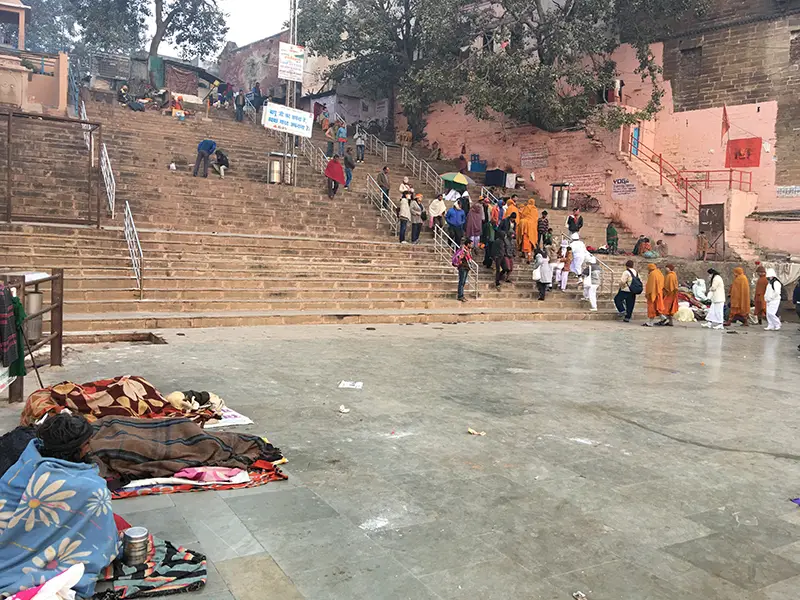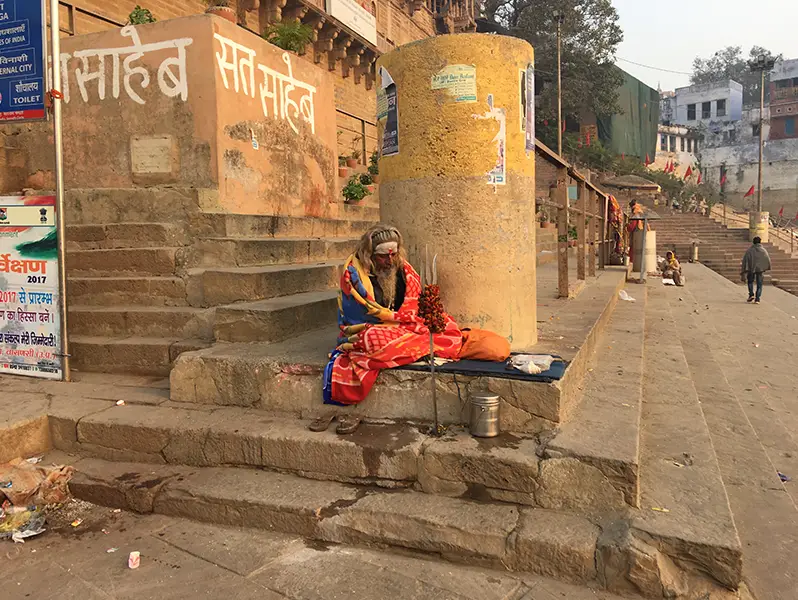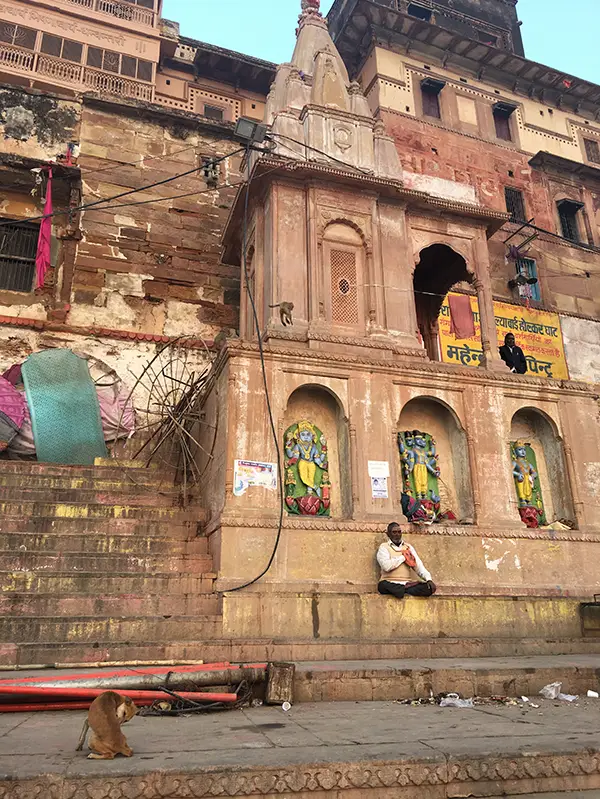Just before the trip we organized to India, to Varanasi, at the end of December 2022, someone told me:
“Oh wow, you’ll see, the Ghats... Modi has built something terrifying, gigantic, all in concrete. They destroyed the old neighborhoods to make a tourist site overlooking the Ganges.”
And indeed, the observation is there—it’s true, the place is striking. An immense site has been literally dropped into the heart of the city, this very ancient city of pedestrian alleys where the decaying bodies of the deceased, carried on four shoulders, rush at full speed toward the Ganges for the liberation of the soul it shelters, according to Hindu traditions.
The place has literally been carved out with a knife. As you can see in these images, the original buildings of this maze of narrow lanes have been cut away to create a perfectly rectangular space into which a concrete, modern site has been poured—an esplanade toward the beyond, even including an escalator that the locals are quick to show us with pride.

Varanasi through my visits
The very first time I discovered the ghats of Varanasi was back in 1977. At that time, it wasn’t even called Varanasi—it was still known as Benares.


Then I returned in 2001, in 2017, and more recently at the end of 2022. It’s true that over the years, the banks of the Ganges have changed. Quays have been built—which is not a bad thing! In the past, some spots were nothing more than rather dirty earthen slopes leading down to the water, and often you had to go up and around to reach another ghat. Today, these quays make it easy to stroll from one ghat to another. Platforms have been installed, offering practice spaces for yogis in a cleaner environment, and small squares now welcome pilgrims, tourists, and visitors alike.
The Ganges, certainly the most sacred river in the world, is also ranked as the fifth most polluted river on the planet… Human wastewater and animal waste disposal, the increase in population density, and the dumping of industrial waste are its direct causes.
Varanasi is the most important Hindu pilgrimage site in India. Every day, some 300 bodies are cremated here, a ritual believed to help the soul realize the merits of its past good deeds as it is released.
The cremation ritual itself involves many stages, which a priest will explain to you if you join us on one of our journeys. But since that is not the focus of this article—though it is indeed a fascinating subject—I will leave it at that for now.


From Varanasi to the Trocadéro
Let’s return to this esplanade. As I walked toward its center, my initial astonishment slowly gave way to a vision. Before me I no longer saw this surreal ghat, but the Trocadéro. The image became clear. I remembered myself, just a few months earlier, standing on the Trocadéro platform, and I wondered: what was it like in the past?
To my great surprise, a quick bit of research revealed that facing the Eiffel Tower—where today we find the Place du Trocadéro—once stood the Old Trocadéro Palace, a magnificent building in a style blending Indian, Persian, Egyptian, and Moorish influences. Its particular design was meant to recall the French victory in Andalusia.
This palace was built for the 1878 World’s Fair, an event that was entirely economic in purpose: to boost France’s industrial drive after the loss of Alsace-Lorraine and to show Europe that France remained a great power.
It was demolished in 1935, with only the wings preserved, to make way for the Palais de Chaillot—since the eclectic design of the old Trocadéro Palace did not please Parisian tastes!


A Significant Sanitary Evolution
Over the decades, I have seen India change. From 1977 to the 2000s, I was struck by the sanitary progress. In 1977, suffering spilled into the streets. Every 20 meters, either a being in a state of extreme suffering displayed the stump of a leg, cut off, with gangrenous, festering flesh—green, yellow, sucked by dozens of flies forming an impenetrable shell, clustered together… Or, each day, I would encounter faces scarred by smallpox—eradicated in 1977 thanks to vaccination, yet the marks remain until the death of those individuals (through old age, illness, etc.), and I confirm that I saw too many, far too many, every single day… Or bodies deformed by polio, elephantiasis, CLOVES syndrome (Elephant Man…), and so many others.
By the 2000s, I saw that vaccination had done its work. Cholera, smallpox, yellow fever, polio, dengue… all of these diseases were either eliminated or under control. And the facts are there. Anti-vaxxers may shout at me—it wouldn’t be the first time—but I wouldn’t know what to tell them, except this: I have seen the before and the after. That’s all. One cannot deny what is reality, even if it displeases our ecological convictions.
Floating body on the Ganges, in Varanasi – Gattini JC Collection, 1977
Overall, sanitary conditions have greatly improved, and I can attest to it in the rawest way. Look at this image. It’s a child. According to Hindu tradition, children are not cremated when they die but placed in a jute sack and directly thrown into the Ganges.
Or perhaps it was a priest? Indeed, other categories of people are not cremated either: they are thrown into the middle of the Ganges, weighed down with stones, or buried along the banks—but with the monsoons, the bodies eventually reappear, half putrefied, in the river… These include priests, sadhus, and pregnant women, their souls being considered pure. Prostitutes, lepers, and those who died from snake bites, seen as impure, are also not cremated. In the past, such bodies would float by frequently, hour after hour…
Today, during the several hours I spent near the Ganges, I observed: I did not see a single one. There are fewer deaths, that’s a fact. And fewer child deaths, that’s certain. We know vaccination plays a key role in this.
To give some perspective, here are a few figures that speak for themselves. Infant mortality—that is, children under 1 year of age—fell from 125 per 1000 in 1977 to 27 per 1000 in 2020! In the 1960s, it was 160 per 1000. By comparison, France was at 12 per 1000 in 1977, 3 per 1000 in 2020, and 24 per 1000 in 1960.

Suffering exists. Whether we want it or not. Whether we look at it or deny it.
The reality of suffering is a fact. Even if we don’t like it, it remains. Suffering is. We can pile on 10,000 protective layers, as is often the case in the West, but that will not erase the suffering that exists.
Visible suffering—the kind one sees when traveling and looking beyond the glossy clichés sold by travel agencies—is indeed there. It is a reality. Even if denied, it is present and it affects far too many beings on this planet.
This suffering also manifests in more subtle forms, as Buddhism teaches, and particularly affects the Westerner who is endlessly seeking more, always dissatisfied, never realizing how much we already have. This too is a reality, whether we accept it or not.
Buddhism offers methods to eliminate mental suffering—those subtle sufferings that keep us endlessly chasing temporary happiness, or constantly caught in aversion. And there also exist methods to reduce physical suffering. Sanitary progress is one of these methods, and vaccination—being part of it—has allowed countless countries to emerge from a hell that may now seem unreal, yet was once a stark, undeniable reality.
2000s – The March Toward Industrialization and the Rise of the Internet
During my stays in India in 2001 and 2002, one of them lasting a full year, I could clearly see industrialization taking hold. The first highways were timidly appearing, now welcoming numerous vehicles. Electricity was becoming more stable, with fewer outages and shorter ones. Running water was increasingly available directly from the taps in guesthouse rooms, replacing the big barrel of water from which one had to scoop with a small pot for showering or flushing.
Everywhere, Indian cuisine was also adapting. The spices were still there, of course—and thankfully!—but it was now possible to ask for food “less spicy.” Back in 1977, as a child, my palate struggled to cope with the sudden, painful shock of chili in its full force, and it was literally impossible to get a plate of plain white rice. Each time we asked, it would arrive tinted yellow and full of flavors… For the anecdote, I survived back then on a diet of fruit, peanuts, street-roasted corn, and baby glucose biscuits.



The other major change—the shock to my eyes—was clothing. Indians had now adopted Western uniformity. Gandhi’s dhoti, once worn by the majority of men, had given way to trousers; and the sari, with its often exposed rounded bellies, had been replaced by tunics and pants.


And the last point—though far from being the least important in the end—was internet access! We are in 2001/2002. Do you remember what it was like in France back then? Just the first baby steps. And yet in India, even while garbage seemed to form a protective layer above rivers and city soil to shield them, perhaps, from UV rays (a little humor… you just have to learn to see each piece of trash as a flower and everything feels okay), despite this unchanging backdrop even today, internet access was already offered on every street corner in 2001!
Internet cafés, each with about ten computers, allowed anyone to connect, communicate, and open their eyes to the other world—the Western world, the world of technology, the world of the future. It was in these very internet cafés, armed with a copy of HTML for Dummies bought in a Delhi shop, that I slowly taught myself how to build my very first websites…
2017 – The March Toward Digitalization
2017 marked another step in this change, this natural evolution of a society on the move, with… digitalization!
In the little shops appeared the first PayTM stickers, inviting customers to pay… with their phones!!! Mobile phones were everywhere—even the sadhus had adopted them. And rightly so. Remember, while on our side we played the prudish mothers, saying things like “Oh, the internet? No, I’d rather stay in my bubble, plant my cabbages, etc…,” Indians very quickly grasped that here was a tool of development, available to everyone.
Seventeen years later—a whole generation later—it is only natural that by 2017 we witnessed the full integration of digitalization into everyone’s daily life. And I do mean everyone. (Read my article on Patel, India’s first digitalized beggar!)
Another striking change was in road construction. I began to see the first elevated roads—viaducts not connecting two hills or mountains, as we build them in the West, but instead soaring over a main artery in order to double its capacity.



2022 – The March Toward Demonetization
2022, the post-Covid era. As I explained in the article just mentioned, the pandemic was a decisive factor in the transition toward digital currency and the generalization of online payments and QR code transactions throughout India. Now everything revolves around these new types of payment. And as I point out in another article, India has just launched its digital rupee—a new step toward a 100% digital system, where coins and banknotes will be nothing more than a distant memory.
As a child, I had the extraordinary privilege of traveling through many countries in Asia, Africa, and South America, and I always brought back coins from those journeys. What sparked this habit was the beauty and variety of Indian coins. At a time when most of the population was illiterate, and when many beggars were blind—whether due to illness or to burns inflicted in the dark networks of human trafficking—the coins had been designed accordingly. They came in all sizes, textures, and shapes. For a child, it was pure joy to collect these little treasures.
The other major development I noticed in this post-Covid period was the rise of the famous elevated roads—those viaducts that layer the traffic arteries of the cities. They literally soar, in both senses of the word! A striking example is in Patna, in Bihar. An incredible aerial network has been developed there. Intersections, branches, roundabouts—everything takes place in the air! One can almost imagine that in fifty years there will be even more levels stacked above, connecting one aerial zone to another on a higher plane…


New roads cut through the countryside and villages, while the old ones are redrawn by slicing straight through houses. You will agree—it breaks the heart.


In the cities, shopping malls stretch their innovative-shaped buildings skyward, lit up with a thousand lights when night falls, creating a kind of visual fairytale that projects a new world centered around temporary, illusory happiness.
And tourism is settling in. It is developing exponentially and struggling to keep pace with the exponential flow of new Indian visitors. You can read this article I wrote a few days ago about the development of tourism in India. And stay tuned to my newsletter, because I’m planning to write another article soon on the growth of Buddhist pilgrimage sites.
A Nostalgic Walk?
As we can see, India has been moving step by step toward a future aligned with the rest of the world, emerging from what could be called its “medieval” era in terms of material conditions. Of course, as tourists, our eyes don’t always like this. We love immersing ourselves in a different environment. We don’t come to India to see places that resemble our own.
Yes, there is the spiritual dimension, inseparable from India—but let’s be honest. Think about it next time you go back. Isn’t there perhaps another layer? Search within yourself. Meditate on it. Observe your sensations when you discover or wander through certain places, and take a picture.
Everyone has the right to a more spacious, leveled, and perhaps less “typical” environment—but isn’t it true that we, too, have appreciated seeing the dirty streets of our own cities transformed over the past 150 years into comfortable, clean, and pleasant spaces to walk through?
The example of the Trocadéro, built to reinforce France’s place in the world, mirrors the transformation of this ghat into a vast esplanade overlooking the Ganges.
There is, in this transformation initiated by Narendra Modi, a vision similar to that of our own leaders when they built the old Trocadéro Palace—manifested today as the Place du Trocadéro.
A Walk Toward the Future
Our humanity is engaged in developing greater comfort, and the challenge now is to do so on the foundation of a spirituality that prevents us from becoming mentally dependent on this comfort, while embracing development based on new ecological and energy technologies.
India has a real card to play here—and it knows it. We in the West had a head start with the rise of the industrial era, and now we must reinvent everything to fit new standards. China has shown that a country can develop its infrastructure and environment very quickly when starting from zero. India is still a step behind, but it has every tool in hand to leap directly into the future—a future that could soon become everyone’s.
We must therefore accept seeing sites change, cities modernize. As a child, we often rode in pousse-pousses—two-seater carriages pulled by a man pedaling under the blazing sun. They still exist in Varanasi, where the alleys are narrow, but elsewhere they’ve been replaced by rickshaws, which are quickly becoming electric and silent. The same is true for horse-drawn carriages, once common, now found only in tourist sites to shuttle visitors from overcrowded parking lots on the outskirts to the destination itself. For example, to take the cable car up Vulture Peak in Rajgir—where the Buddha taught the Prajnaparamita, as I discuss in another article.
And so it is that the G20 Summit 2023 will be held in Delhi, on September 9–10.
India now boasts the fastest economic growth in the world and, thanks to its ongoing urbanization and modernization, is set to accelerate further. This year, it has overtaken China as the most populous country, with 1.4 billion people. By 2027, its GDP is expected to surpass that of Japan and Germany, according to forecasts. In 2022, India’s growth was projected at 6.8%—twice as fast as the global economy.

The Mindful Path of Spiritual Travel
When we travel, we must cultivate a virtuous state of mind: traveling with awareness. Not as voyeurs, staring at the differences in comfort, cleanliness, or opportunities between the people we visit and our own lands—only to forget everything once we return to our little personal comforts. Instead, we should travel by opening ourselves to the messages that these so-called “exotic” peoples and lands can offer us in terms of inner transformation.
Travel must be an inner enrichment.
Enrichment means growing, with the awareness that the balance of the world will only manifest through the transformation of all beings toward positive, compassionate, and supportive states of mind—above all, impartial ones. That is, oriented toward everyone, without discrimination, working in perfect collaboration.
✨ To be continued and discovered with us during our upcoming journeys! ✨

















Ajouter un commentaire
Commentaires